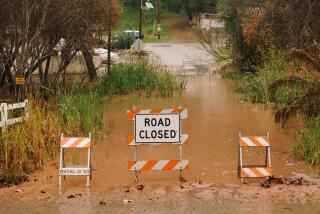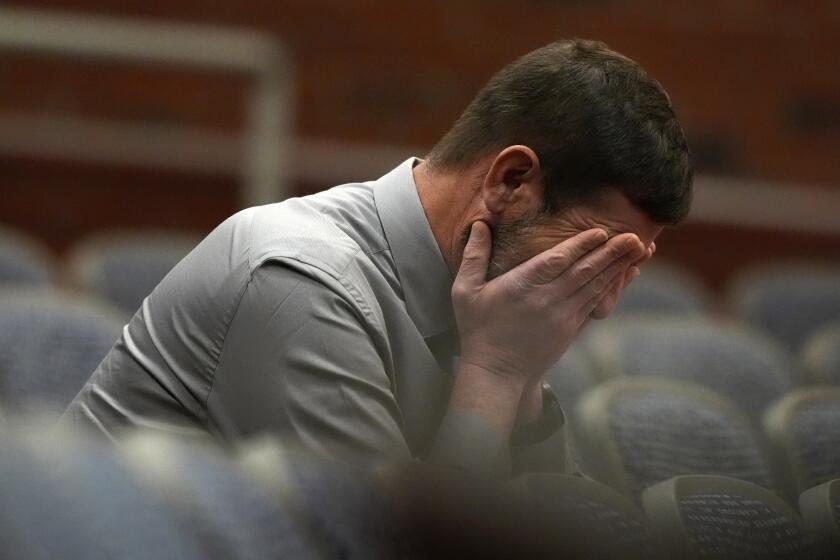Dust storm shrouds Texas city
Even by Texas standards the dark, dense, 8,000-foot-high behemoth of a dust storm that enveloped Lubbock had folks making comparisons Tuesday to the great Dust Bowl of the 1930s.
It was “Steinbeck-ish in its arrival,” said 71-year-old Paul Beane, a Lubbock city councilman, who watched the storm roll in Monday evening from his front porch. “I expected at any moment to see a line of Model Ts coming through headed to California. It really did look like pictures I had seen of the Dust Bowl of the 1930s.”
Winds kicked up to 75 mph. The sky turned darker than a thunderstorm. And then a blinding, rust-colored cloud blew into town with a vengeance. In what meteorologists described as a rare event because of the size of the cloud, the dust storm knocked out power, tipped small planes, toppled trees, damaged an airport hangar and a fire department roof and had people sweeping and brushing off a thick coating of dirt.
With the ongoing drought across the Southwest, experts said, the dust clouds could become more commonplace.
Smaller dust storms are common in Lubbock, the “Hub City” of the South Plains, home to 230,000 people about 300 miles west of Dallas. But the conditions that caused Monday’s storm were unusual, similar to those that generated enormous dust clouds in Arizona in recent months.
The cloud formed what meteorologists call a haboob, an Arabic term used to describe a violent dust storm or sandstorm. Justin Weaver, a meteorologist in charge at the National Weather Service office in Lubbock, said Arizona’s dust storms were driven by thunderstorms. “We have the same situation when we get a haboob — it’s driven by convection,” he said. “This one was a little different because it was driven by the leading edge of a cold front.”
The storms can be traced, at least in part, to the Southwest’s long-lasting drought, which the Texas climatologist has said could endure for a decade. As the dry spell continues, another cold front could stir up a similar dust cloud in coming months, Weaver said.
“There’s very few crops in the fields; almost all the cotton crops failed,” Weaver said. “It’s similar to what we saw during the Dust Bowl years of the 1930s.”
Councilman Beane said Lubbock residents still told stories about how Depression-era dust storms turned the town so dark, chickens went to roost in the middle of the day. Now he said the next generation had its own dust storm story.
Lubbock Mayor Tom Martin was selling pumpkins outside his church when he saw a dense, black cloud on the horizon.
“It looked like nighttime coming real quick. It got very, very dark in a hurry,” Martin said.
On Tuesday, crews were still working to restore power to some residents, and street sweepers were clearing the remaining layer of red dust, according to city spokesman Jeff McKito.
McKito was on his way home from picking up a pizza Monday night, driving the downtown highway loop, when the dust storm hit.
“It blocked out the sun,” he said. “I couldn’t even see the Sam’s Club right off the loop, there was so much dirt in the air.”
Over at Estacado High School, the football team watched in awe as the cloud approached, trying to figure out what it was. As soon as they did, they ran inside, where the girls’ volleyball team and the drama club were practicing. Then the school lost power and practice was cut short, according to Principal Sam Ayers. A nearby middle school canceled a volleyball game so students could take shelter.
“We had a lot of dirt to clean out this morning,” Ayers said, and the school was still trying to fix its bell and clock system, which were thrown off by the outage.
“Somehow,” he said, “students still seem to know when it’s time to get out of class.”
molly.hennessy-fiske@latimes.com
More to Read
Start your day right
Sign up for Essential California for news, features and recommendations from the L.A. Times and beyond in your inbox six days a week.
You may occasionally receive promotional content from the Los Angeles Times.







